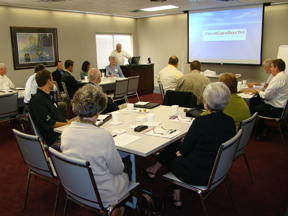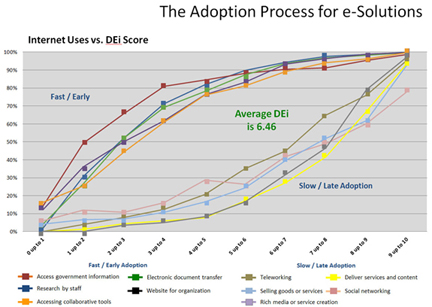
Change is Hard… and So is Utilization
by Michael Curri & Doug Adams
In work across four American States, SNG research has found that not all e-solutions are created equally. Some are relatively easy to drive adoption and utilization… some are extremely different and require overcoming great challenges. When we plot out the utilization of various e-solutions versus SNG’s proprietary Digital Economy index (DEi) which measures the utilization of broadband as a platform for innovation, we see just how hard in what we’ve dubbed our “football chart” below. As a reminder, DEi scores range from 1 to 10 (10 being highest), with higher scores reflecting the greater the number, scope and sophistication of the Internet activities deployed in an organization.
As we discussed last month – businesses with a high DEi, meaning higher levels of adopting and using e-solutions, experience larger percentage increases of revenues (between 27 and 31%). Increasing Internet utilization dramatically increases corporate revenues and job creation.
So what does this have to do with the football chart? Let’s dig deeper and look at what separates the more successful organizations in utilizing broadband, creating efficiencies and growing revenues. It’s not the easy, “quick to adopt” solutions that include accessing government information online, sharing files, using collaborative tools, online research, and companies hosting their own website. These are all basic and even unsophisticated businesses are doing these.
But what separates the mediocre from the great… who is “winning” according to SNG’s research and the ‘football chart?’ The organizations that take on the difficult challenges, the more complicated e-solutions, are the businesses that are utilizing broadband to grow their business. These include:
- Teleworking – Using the Internet as your “virtual office,” enabling a geographically disparate workforce.
- Rich media – Creating multimedia content and interactive tools to market products/services and increase sales opportunities
- Social networking – Using today’s social network forums to promote business and collaborate with peer groups and colleagues
- eCommerce – Selling goods or services online – this can include driving leads toward payment and does not require online payment.
- Deliver services or content online – From customer service departments to digitized products.
Are you focusing on simply providing broadband and waiting for people to adopt… and ultimately utilize e-solutions (the tried and failed build it and they will come mentality) or are you driving utilization? Focus on driving sophisticated use of broadband and you’ll see your region’s economy reap the benefits. SNG has helped to look at where gaps are and prescribe next steps for economic development through broadband in communities and regions.
SNG Workshop in SC Helps to Drive Network Utilization
Earlier this month SNG’s Michael Curri and Derek Murphy travelled to South Carolina to assist in their broadband initiatives. Held by the Clemson Institute for Economic and Community Development and West Carolina Rural Telephone Cooperative (WCTel), the day long workshop gathered stakeholders interested in examining how broadband could help create a healthy and vibrant regional economy.
 Dave Herron, CEO of WCTel, explained that after completing a Fiber-to-the-Premise network throughout their rural service area, “we were faced with the challenge of trying to get our communities and economic development professionals to realize the value of the infrastructure they had available to them.”
Dave Herron, CEO of WCTel, explained that after completing a Fiber-to-the-Premise network throughout their rural service area, “we were faced with the challenge of trying to get our communities and economic development professionals to realize the value of the infrastructure they had available to them.”
 And that’s where SNG stepped in, along with Clemson University’s Institute of Economic and Community Development, to conduct a workshop for local economic development professionals, educational communities, Chambers of Commerce, State Dept. of Commerce, and several other community leaders. SNG’s expertise in maximizing the desirable outcomes enabled by investment in advanced broadband infrastructure were seen a key to demonstrate “what’s possible” with the WCTel network.
And that’s where SNG stepped in, along with Clemson University’s Institute of Economic and Community Development, to conduct a workshop for local economic development professionals, educational communities, Chambers of Commerce, State Dept. of Commerce, and several other community leaders. SNG’s expertise in maximizing the desirable outcomes enabled by investment in advanced broadband infrastructure were seen a key to demonstrate “what’s possible” with the WCTel network.
Explains Herron, “We needed to show local leaders how to utilize the network to promote economic and social development. We are committed to educating the community and are extremely hopeful that the leadership group formed will help in that effort, demonstrating to the communities how network utilization will to attract new industries, enhance existing businesses, and create jobs for our communities.”
Michael Curri explained how exciting it was to see a strong desire among the participants to work together – that day and in the future as they organized. “We helped create real momentum – it will be exciting to see the socio-economic benefits that will be realized thanks to the combination of the WCTel network and a mobilized leadership group.”
No Job doesn’t Mean No Earning Potential
- More from the SNG research front before we put a wrap on this month’s Bandwidth. It is encouraging to see 1 out of 4 of unemployed individuals using the Internet to start a home business. Another 25% are relying on the Internet for education and training to help them get their next job. Even the retired are using the Internet for both of these purposes.
Obviously, when considering how to cut back on personal expenses, the Internet bill should be taken off the table. Is it time that unemployment insurance include an Internet stipend? It’s worth considering given our findings.
n= 229 unemployed, 868 retired


